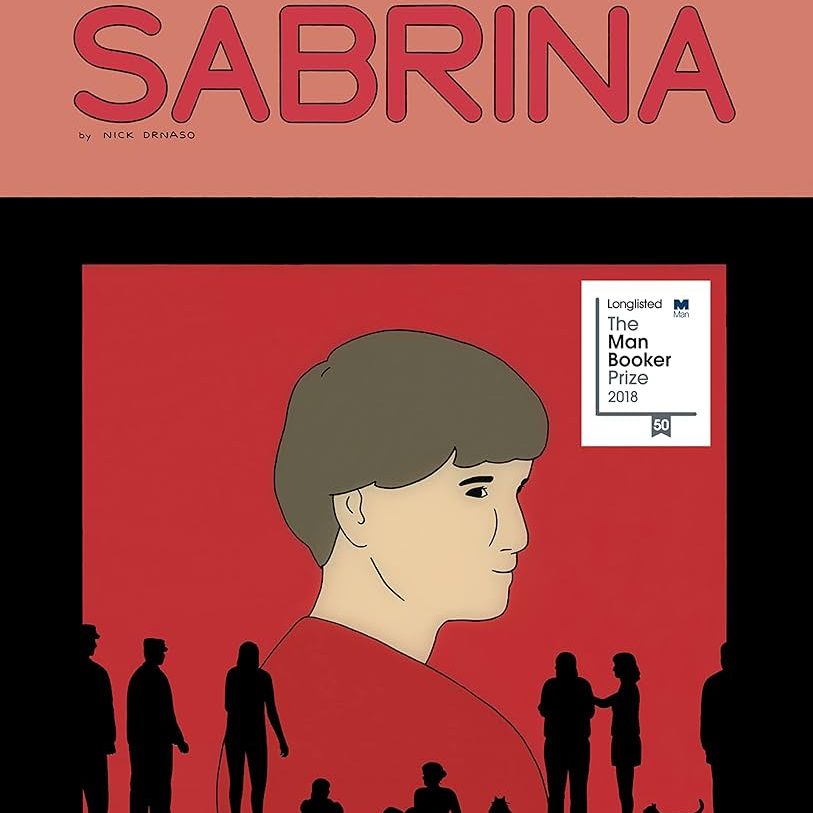But between these posts, something catches your eye: a video of grotesque violence that rocks you to your very core.
Yet, you can’t look away.
Let me set a scene: it’s late and you’re doom-scrolling through social media posts the algorithm has generated for you, ranging from tailor-made advertisements for the “sustainable” clothing that was made in an Asian sweatshop, to posts by that girl you sort of know who is now on her fourth holiday this year, yet the retail pay-check doesn’t quite explain how she’s currently sunbathing in Monaco.
But between these posts, something catches your eye: a video of grotesque violence that rocks you to your very core.
Yet, you can’t look away. And before you know it, three minutes and thirty-six seconds have passed, the video has ended, and an advertisement for face cream plays next.
In the early days of the internet, it was grainy CCTV footage of workplace accidents in which blood is but a smattering of red pixels; perhaps it was terrorist-related violence, the beheading of an individual in their final moments; or perhaps it’s brutal car crashes being turned into internet memes, sick laughter emerging from suffering. Irrespective of whatever format it took, I am certain you have experienced or will experience, such a thing in your modern life.
But why didn’t you look away?
Nick Drnaso’s Sabrina, a chilling graphic novel, perfectly encapsulates this stranglehold violence has on us, aiming to convey the issue our society has with “consuming” violence, and the emotional numbness this creates, with a The New Yorker article interviewing Drnaso stating that he “has spent many hours in the darker corners of the internet”, alongside a quote from himself that there is “a morbid curiosity in [him]” (Max).
No blood, no grisly details. Just nonchalant descriptions of death.
Within Sabrina, Nick Drnaso portrays a world in which, like our own, violence is never far away. The novel details the murder of the titular Sabrina Gallo, and portrays the aftermath of the incident on her boyfriend Teddy, who goes to stay with old friend Calvin, with both men experiencing crises in their lives due to conspiracy theories surrounding Sabrina’s murder.
Yet, despite Sabrina being a graphic novel, there are no real visuals of violence; instead, we are presented with characters reacting to or discussing it, with these very acts depicted outside of our periphery. Sabrina’s death is never actually described for the reader, not that it really needs to be. Instead, we are informed of her death through third parties, relayed information by journalists who state, “We just received a tape at our office that appears to show a young woman being murdered” (69). No blood, no grisly details. Just nonchalant descriptions of death.
“We just received a tape at our office that appears to show a young woman being murdered”
Nick drnaso, sabrina. page 69
In the pages that follow, detectives investigate the scene of the crime, with little dialogue uttered and minimal violence visually portrayed. But what startles most is the depiction of these detectives through Drnaso’s illustrations, the simplistic style mirroring that of workplace training videos, in which they are entirely unphased by what has occurred around them. In some panels, they even appear to have smiles on their faces (Page 72), entirely disaffected by the violence witnessed.
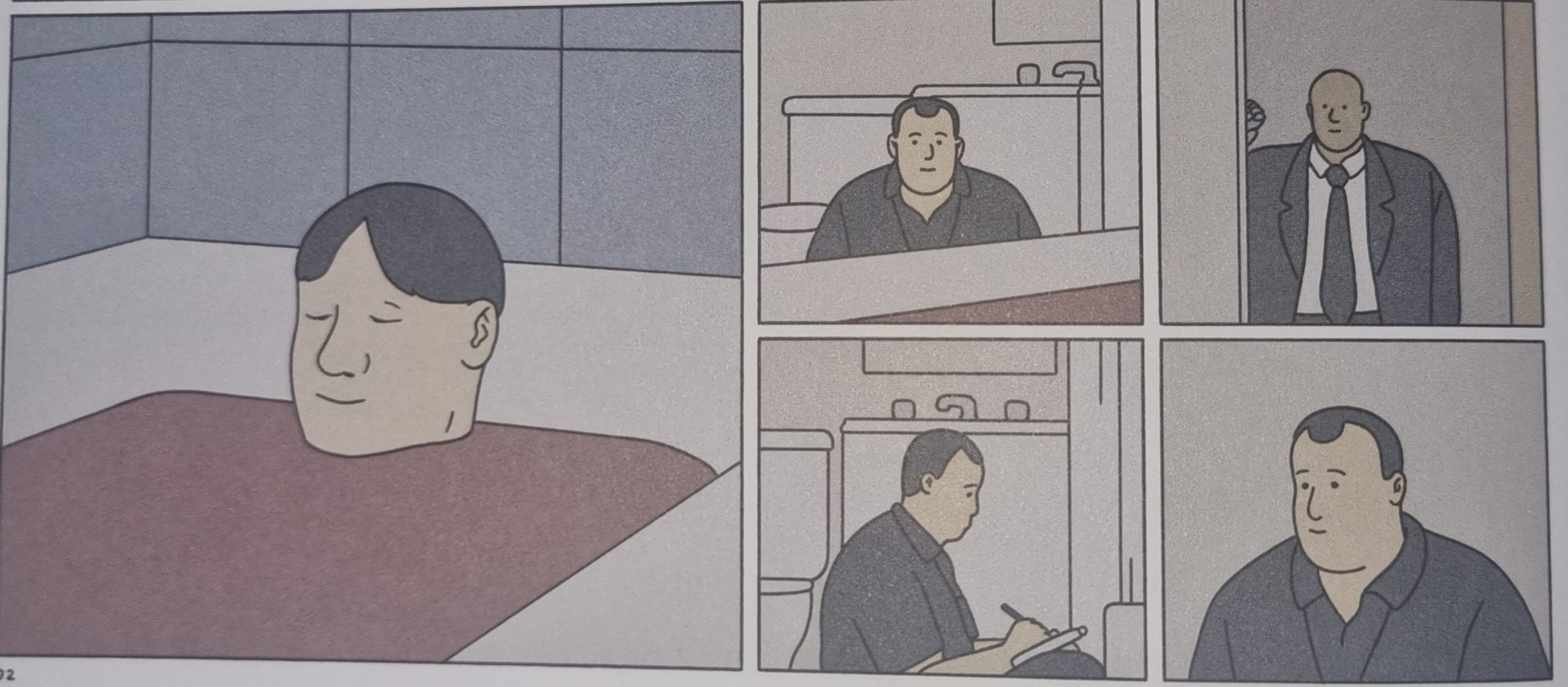
Later in the novel, Calvin uses social media to find information on Timmy Yancey, Sabrina’s murderer, with Dsrano illustrating a trending social media page in which Timmy and Sabrina’s names are the first and fourth most trending topics on the platform, respectively, accompanied by other consumable medias such as sports matches and superhero movies. (Page 81)
In the panel beside this, however, is a chilling message; an unnamed individual, replying to posts about Timmy with the comment “I NEED to see this”. (Page 81)
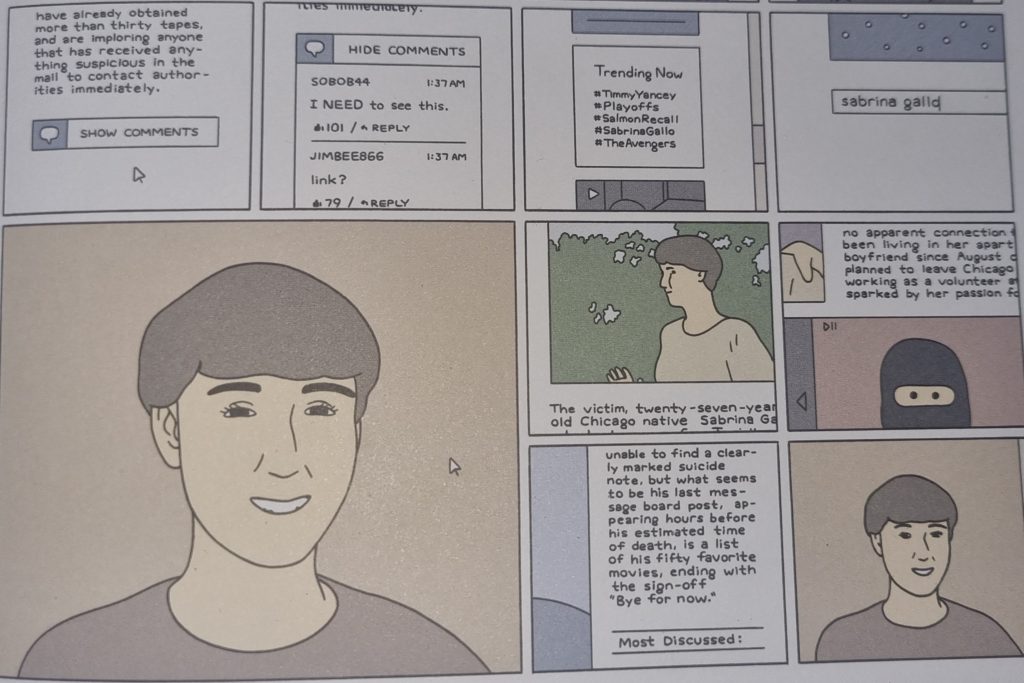
“I NEED to see this”
Nick drnaso, Sabrina. Page 81
What follows is Calvin himself seeking out this video, for what purpose we do not know. We are never shown the video itself, but rather the aftermath, in which Calvin is physically sick. The only description we have is presumably Timmy’s voiceover during the video, in which he states that such violence “is only a means to an end” in a last-ditch attempt to be heard (Page 114).
But why didn’t Calvin look away?
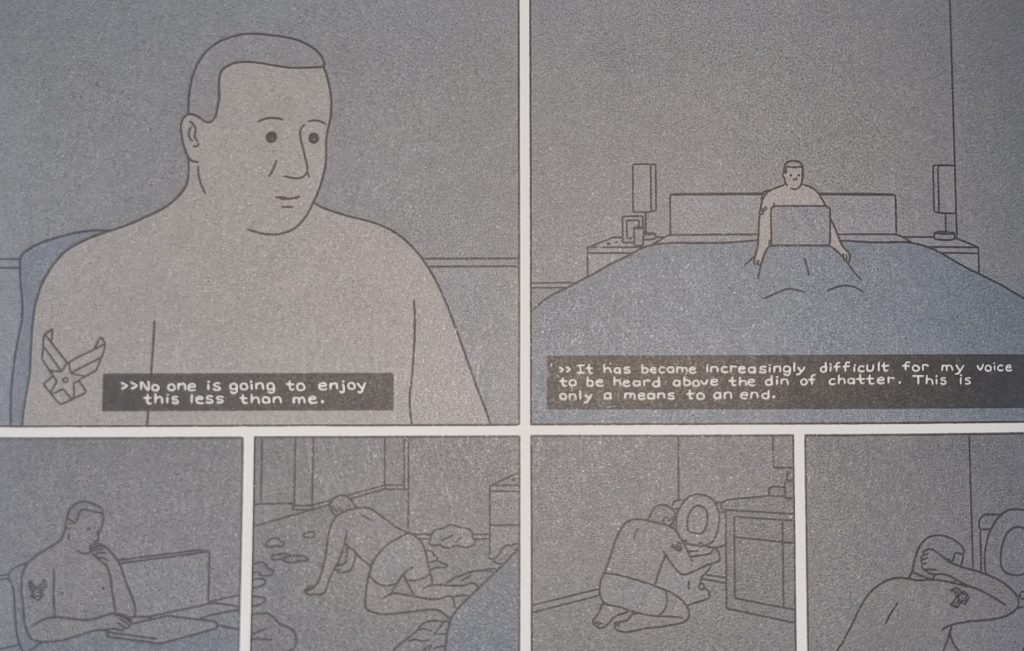
In research conducted at Trinity College, Simon McCarthy-Jones discusses those who watch such acts of violence, coining them “white knucklers”, in that “like adrenaline junkies, they feel intense emotions […] but they dislike these emotions. They tolerate it because they feel it helps them learn something about how to survive” (McCarthy-Jones). McCarthy-Jones discusses these portrayals of violence as an educational experience, comparing them to the way that “‘painful’ cringe comedies may teach us social skills, watching violence may teach us survival skills” (McCarthy-Jones). Therefore, is the viewing of this violence by Calvin an act of morbid curiosity to “strengthen” himself? In turn, is this our subconscious thought behind why we too can’t look away from such videos?
“White knucklers… [are] like adrenaline junkies, they feel intense emotions […] but they dislike these emotions. they tolerate it because they feel it helps them learn something about how to survive”
Simon mccarthy-jones, trinity college dublin
As later events in the novel unfold, the ever-looming presence of violence continues to feel all too real. Yet, Calvin becomes ever-more desensitized, unfazed by the events in the world surrounding him. At work, Calvin and his fellow airmen discuss a domestic terrorist “stream[ing] this video on Facebook, then killed everyone in a daycare centre and himself” (Page 143). Through Drnaso’s art, we see that the airmen, like the detectives, are entirely numb to this violence, eliciting no emotion, despite the personal relevance to Calvin, as his daughter is the same age.
Is the viewing of this violence by Calvin an act of morbid curiosity to “strengthen” himself? In turn, is this our subconscious thought behind why we too can’t look away from such videos?
However, what follows next is more chilling – in the panels that follow, Calvin views a social media trending page, in which this “Denver Massacre” is number one. Although we are left in the unknown as to whether he views the video, his nonchalant question of “Cigarette, anyone?” and his psychological evaluation as middle-of-the-road (both Page 144) both perfectly encapsulate the numbness Calvin possesses towards these acts of violence now. Through their readily available proximity online, these videos have erased empathy, disgust and emotion from his character, reflective of wider society at large.
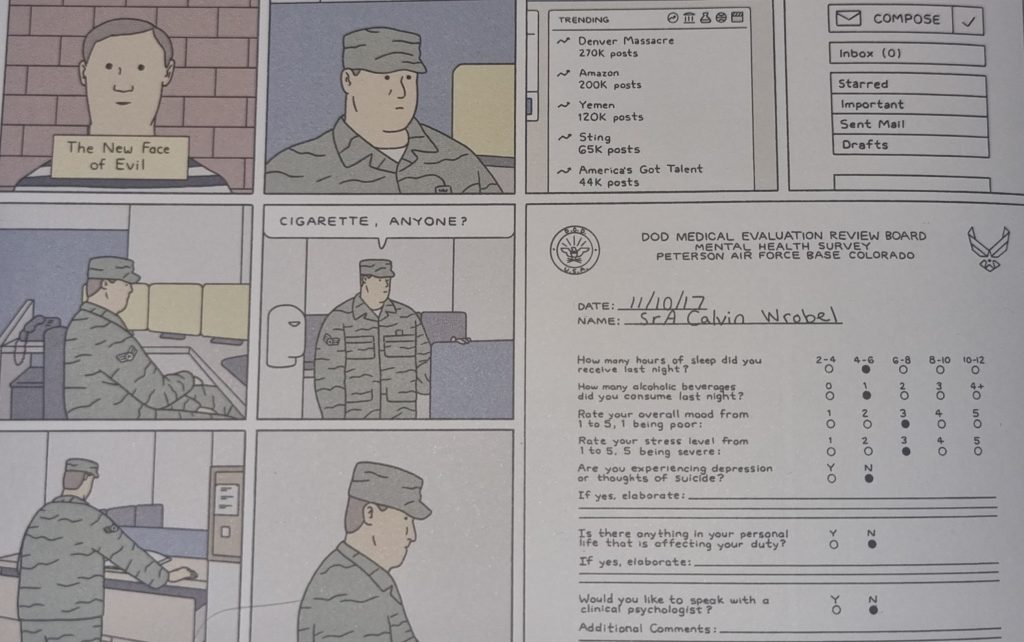
Through their readily available proximity online, these videos have erased empathy, disgust and emotion from his character, reflective of wider society at large.
Therefore, I suggest that Drnaso’s portrayal of violence is an act of reflection, forcing his readers to question why we watch violence, and why we seek out such videos that are depicted in the novel. In her review of Sabrina, Rita D. Jacobs remarks that the “power of the graphic novel to dissect and examine our cultural moment is indisputable” (Jacobs), supporting the idea what is visually illustrated on the page is equally as crucial as Drnaso’s writing.
“The murder is incidental to the chilling indictment at the heart of the narrative – that of what our society has become”
Rita D. Jacobs, in her review for world literature today
However, Jacobs’ claim that “the murder is incidental to the chilling indictment at the heart of the narrative – that of what our society has become” (Jacobs) ultimately embodies what I believe to be the most important facet of this novel’s story; it is not a narrative that occupies itself with Sabrina’s death, nor the wider loss of life elsewhere in the novel. Rather, it focuses on the aftermath of such violence, exploring the societal ramifications, and portraying the personal numbness the individual experiences upon viewing and “consuming” these acts of violence.
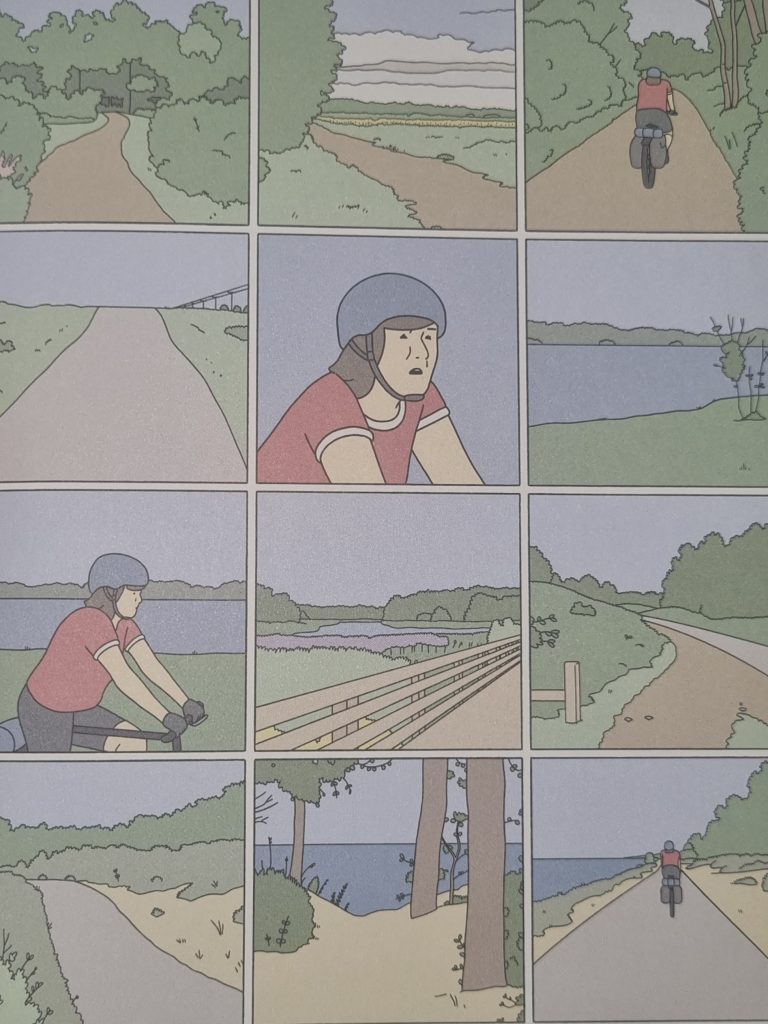
Bibliography
Primary Text
Drnaso, Nick. Sabrina. London Granta, 2018.
Secondary Texts
D. Jacobs, Rita. “Sabrina by Nick Drnaso.” World Literature Today, 2018, www.worldliteraturetoday.org/2018/november/sabrina-nick-drnaso. Accessed 14 Nov. 2023.
Max, D. T. “The Bleak Brilliance of Nick Drnaso’s Graphic Novels.” The New Yorker, 14 Jan. 2019, www.newyorker.com/magazine/2019/01/21/the-bleak-brilliance-of-nick-drnasos-graphic-novels.
McCarthy-Jones, Simon. “From Tarantino to Squid Game: Why Do so Many People Enjoy Violence?” The Conversation, 28 Oct. 2021, theconversation.com/from-tarantino-to-squid-game-why-do-so-many-people-enjoy-violence-170251.
Roach, Jason, et al. “Dealing with the Unthinkable: A Study of the Cognitive and Emotional Stress of Adult and Child Homicide Investigations on Police Investigators.” Journal of Police and Criminal Psychology, vol. 32, no. 3, Nov. 2016, pp. 251–62, https://doi.org/10.1007/s11896-016-9218-5.
